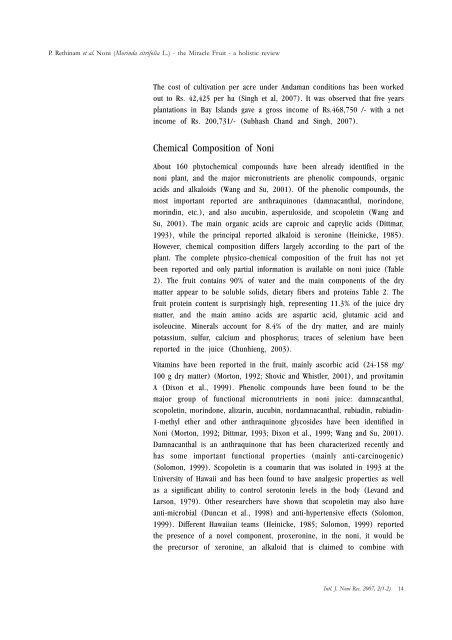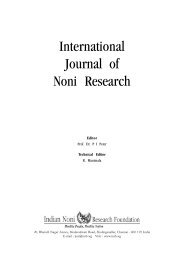International Journal of Noni Research - Noni Family
International Journal of Noni Research - Noni Family
International Journal of Noni Research - Noni Family
Create successful ePaper yourself
Turn your PDF publications into a flip-book with our unique Google optimized e-Paper software.
P. Rethinam et al. <strong>Noni</strong> (Morinda citrifolia L.) - the Miracle Fruit - a holistic review<br />
The cost <strong>of</strong> cultivation per acre under Andaman conditions has been worked<br />
out to Rs. 42,425 per ha (Singh et al, 2007). It was observed that five years<br />
plantations in Bay Islands gave a gross income <strong>of</strong> Rs.468,750 /- with a net<br />
income <strong>of</strong> Rs. 200,731/- (Subhash Chand and Singh, 2007).<br />
Chemical Composition <strong>of</strong> <strong>Noni</strong><br />
About 160 phytochemical compounds have been already identified in the<br />
noni plant, and the major micronutrients are phenolic compounds, organic<br />
acids and alkaloids (Wang and Su, 2001). Of the phenolic compounds, the<br />
most important reported are anthraquinones (damnacanthal, morindone,<br />
morindin, etc.), and also aucubin, asperuloside, and scopoletin (Wang and<br />
Su, 2001). The main organic acids are caproic and caprylic acids (Dittmar,<br />
1993), while the principal reported alkaloid is xeronine (Heinicke, 1985).<br />
However, chemical composition differs largely according to the part <strong>of</strong> the<br />
plant. The complete physico-chemical composition <strong>of</strong> the fruit has not yet<br />
been reported and only partial information is available on noni juice (Table<br />
2). The fruit contains 90% <strong>of</strong> water and the main components <strong>of</strong> the dry<br />
matter appear to be soluble solids, dietary fibers and proteins Table 2. The<br />
fruit protein content is surprisingly high, representing 11.3% <strong>of</strong> the juice dry<br />
matter, and the main amino acids are aspartic acid, glutamic acid and<br />
isoleucine. Minerals account for 8.4% <strong>of</strong> the dry matter, and are mainly<br />
potassium, sulfur, calcium and phosphorus; traces <strong>of</strong> selenium have been<br />
reported in the juice (Chunhieng, 2003).<br />
Vitamins have been reported in the fruit, mainly ascorbic acid (24-158 mg/<br />
100 g dry matter) (Morton, 1992; Shovic and Whistler, 2001), and provitamin<br />
A (Dixon et al., 1999). Phenolic compounds have been found to be the<br />
major group <strong>of</strong> functional micronutrients in noni juice: damnacanthal,<br />
scopoletin, morindone, alizarin, aucubin, nordamnacanthal, rubiadin, rubiadin-<br />
1-methyl ether and other anthraquinone glycosides have been identified in<br />
<strong>Noni</strong> (Morton, 1992; Dittmar, 1993; Dixon et al., 1999; Wang and Su, 2001).<br />
Damnacanthal is an anthraquinone that has been characterized recently and<br />
has some important functional properties (mainly anti-carcinogenic)<br />
(Solomon, 1999). Scopoletin is a coumarin that was isolated in 1993 at the<br />
University <strong>of</strong> Hawaii and has been found to have analgesic properties as well<br />
as a significant ability to control serotonin levels in the body (Levand and<br />
Larson, 1979). Other researchers have shown that scopoletin may also have<br />
anti-microbial (Duncan et al., 1998) and anti-hypertensive effects (Solomon,<br />
1999). Different Hawaiian teams (Heinicke, 1985; Solomon, 1999) reported<br />
the presence <strong>of</strong> a novel component, proxeronine, in the noni, it would be<br />
the precursor <strong>of</strong> xeronine, an alkaloid that is claimed to combine with<br />
Intl. J. <strong>Noni</strong> Res. 2007, 2(1-2) 14








